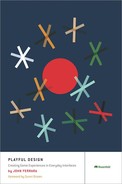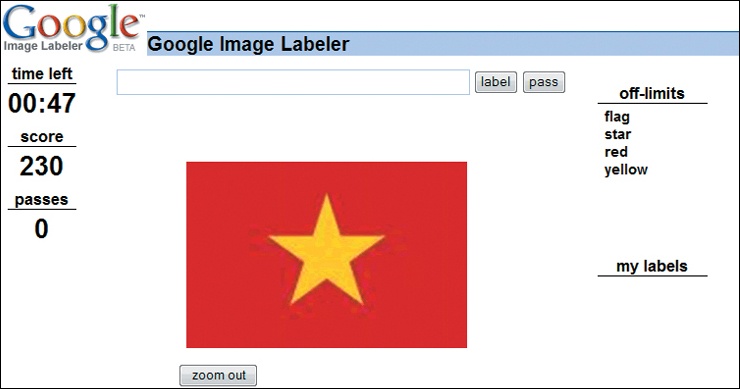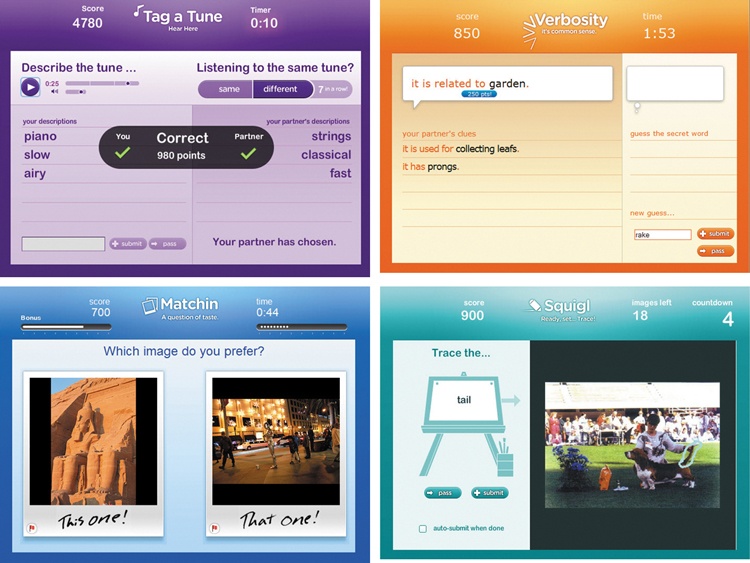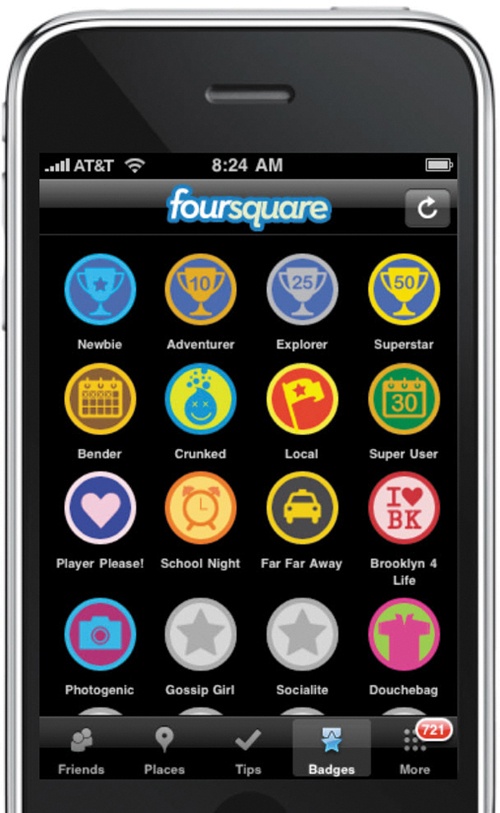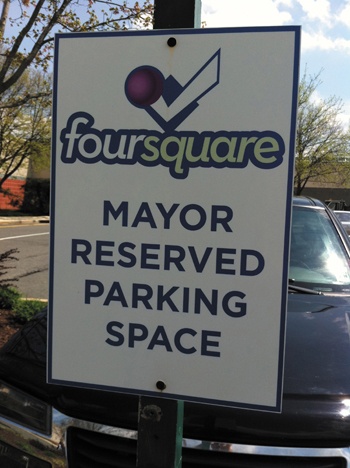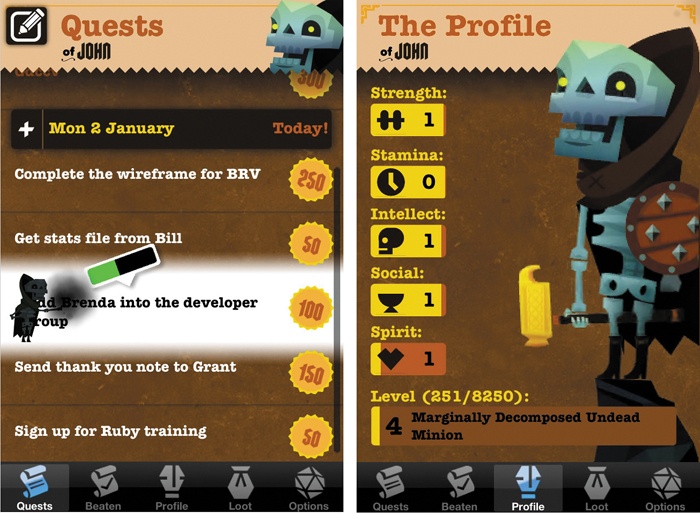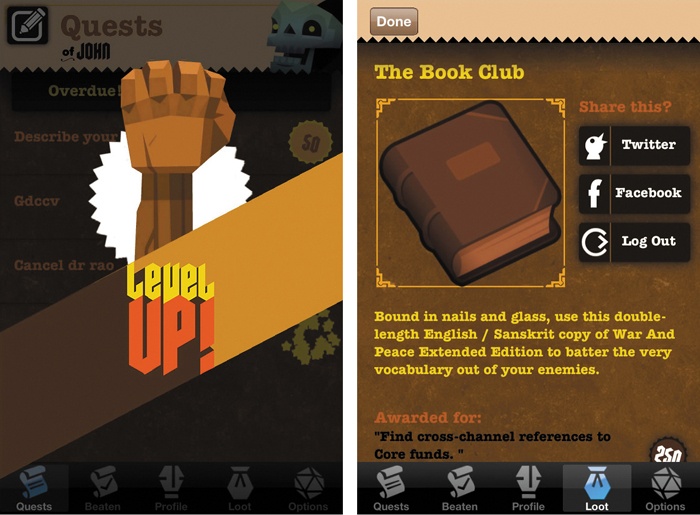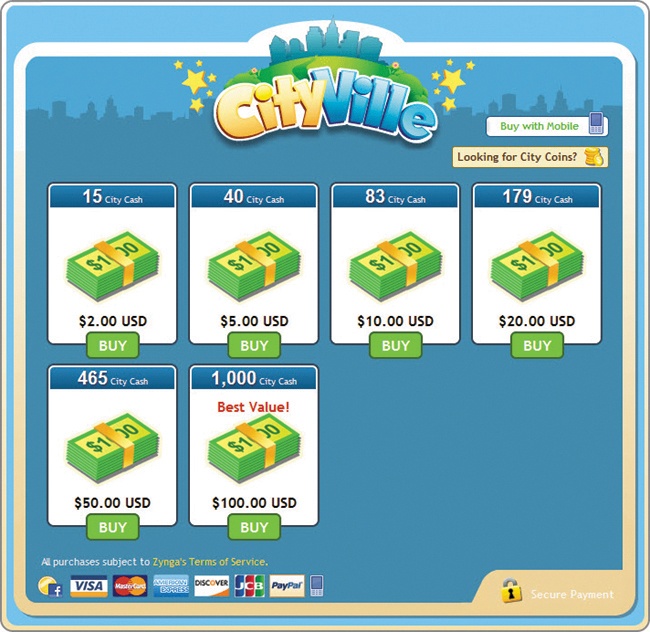Conventional UX design can be intrinsically limiting in that it’s centrally concerned with supporting the objectives that users already have when they arrive at the experience, whether that’s balancing their checkbook, reconnecting with high school buddies, or shopping for a new pair of mittens. We design this way with good reason, of course; it only makes sense to build systems that allow people to accomplish the objectives that create a demand for those systems in the first place.
However, as discussed in Chapter 2, one of the characteristics of games is that the designers set the objectives for the players, who willingly accept those tasks because they value the experience of playing the game. By incorporating players’ actions in the real world into gameplay, UX designers can gain access to people’s systems of motivation and craft game experiences that will move users to action and achieve something beneficial. Importantly, this method should be applied only in cases where users already see value in taking such action but don’t always have the inspiration to make it happen.
Suppose, for example, that you want people to tag images on the Web, adopt more fuel-efficient driving habits, or make micropayments to a charitable cause. Each of these tasks requires mass participation to be effective, but you can’t realistically expect participation from anyone beyond the narrow minority who feel truly motivated to participate in the first place. There are even a lot of people who believe these are good things to do but lack the drive to get up and take action themselves. Without that conviction and commitment, conventional UX approaches can’t succeed. Yet each of these tasks has been successfully arranged as a game experience in the real world, as I’ll describe in this chapter.
This is not to say that there’s anything wrong with the way interfaces are usually built. The imperative to design for existing user objectives has transformed modern software, and believe me, I am all for sticking to that approach whenever you’re working with a sufficiently motivated set of users. But when you’re not, game design can offer a very useful set of tools for bringing people into an experience.
This chapter focuses on an application of games that shares some similarities with how games are applied to educating and to persuading (the subjects of the next two chapters). The critical difference, however, is that games that motivate player action don’t need to be concerned with transforming what people understand or believe. Instead, they are focused on the extent to which players act differently in the external world from how they would act if the game didn’t exist.
A primary consideration for the design of a game that motivates player action is the efficiency with which playing generates solutions in the real world. Understanding this point leads to a few key questions you need to ask when you’re designing a game.
How much will the average player be motivated to contribute? Better designs will motivate each player to provide more work per session of play. Not that every person needs to make a substantial contribution; a small number of people who are really into the game can make up for a broader majority who engage it in passing. Foldit, the protein-folding game discussed in Chapter 1, puts all new players through the same set of well-trodden introductory puzzles, from which it gains no useful information. The game cannot be successful unless it has a fair number of very dedicated players.
How long will each player contribute? Consider not only the time that players will spend in a single sitting, but how often they will return to the game and how long they will continue to contribute. You’ll realize greater benefit from games that are played over many sittings, so allowing players to save their progress and return later should be a top priority. Better still, games that have no true ending encourage players to keep contributing until their interest naturally expires. Open-ended games like The Sims periodically introduce new expansions to keep players playing.
How many people will contribute? The advantages you gain from maximizing the average contribution per session and the total playtime will be multiplied by the number of people playing it, so it’s very important to consider whether the game you’re designing has broad appeal. Remember that the point of building the game is to extend interest beyond those who were motivated to help out in the first place. Games like Words With Friends have appeal that cuts across multiple demographics, allowing them to include enormous numbers of players.
How much do I need to spend to get the desired contribution? Create an estimate up front of the total costs of designing, developing, launching, marketing, and maintaining the game over time. Then set objectives for the benefit (contributions made, number of people signed up, number of items processed, and so on) that you need to receive to justify each dollar spent. These numbers will help drive decisions about the game’s design by defining the responsibilities it needs to meet to be worthwhile. The massive overhead of technologically sophisticated games like World of Warcraft presents too much risk. Remember that people can find enormous satisfaction in simple games like Bejeweled.
Games that are built for human computation repurpose game interactions into useful by-products, which can be applied to tackle thorny problems in the real world. For example, Google Image Labeler (Figure 11-1) was designed to generate tags for Web images that have none so that they can be meaningfully indexed and searched. The game randomly pairs two people logged onto the Internet and shows both players the same image. They must then submit tags for the image, attempting to come up with the same words (they can’t directly communicate with one another). When they hit on the same terms, they’re both awarded points and move on to the next image. The game ends after a certain amount of time has passed, and players’ scores are added to a leaderboard.
Figure 11-1. It’s hard to describe this image without using any of the words listed in the upper right corner, unless you know that it’s the flag of Vietnam.
The game’s structure is intended to maximize the number of reliable tags that players submit. There’s advantage in entering as many tags as come to mind, because doing that increases the probability of hitting a match before the time runs out. The tags can be considered reliable descriptions of the image because the two players, who cannot collude with each other, independently selected the same word from the entire universe of words in the English language to describe it. As a measure of reliability, the system can also match each player’s tags with those submitted by other players who received the same image.
Google Image Labeler was designed by Dr. Luis von Ahn, a researcher at Carnegie Mellon University and a pioneer in human computation. He describes games as algorithms that are executed by people instead of machines. In his games, players process things that are difficult for computers to handle, such as language, images, and ideas.
Von Ahn classifies his portfolio of human computation games into three categories:
Output agreement. Two players are given the same input and must find similar ways to describe it. Google Image Labeler is an example of an output agreement game.
Input agreement. Two players need to describe to each other an object they’ve been given, and decide whether they were both given the same thing. Tag a Tune, described in the next section, is an example of an input agreement game.
Inversion problems. One player is given an object and must describe it to the other player, who has to guess what it is. Password is an example of an inversion problem game.
Google Image Labeler was one of several related games designed by von Ahn to demonstrate applications of human computation, which he collectively titles “games with a purpose.” Other games in the series illustrate different approaches to human computation (Figure 11-2).
Tag a Tune. An input agreement game in which two players listen to a music clip, describe it to each other, and then determine whether they’re hearing the same music. This game produces such subjective tags as “airy,” “classical,” “guitar,” or “rocking.”
Verbosity. Essentially an online version of Password, in which one player is given a term and needs to help the other player guess the term by completing phrases like “It is a type of ...,” “It looks like ...,” or “It is the opposite of ...”. The phrases allow the game to create output that informs ontologies cataloging the relationships between ideas.
Matchin. An output agreement game in which players are shown two images and asked to pick the one they like better. Players get points when they pick the same picture. This design cleverly forces players to consider the types of images they think will appeal to other people to inform functions along the lines of Flickr’s “Interestingness” filter.
Squigl. A game that relies on output agreement to identify the portions of an image to which a given tag applies. Fed by results from the ESP Game, each player is given a noun-based tag and must draw a circle around the area of the picture in which it appears. Players receive points that reflect the extent to which their circles overlap.
It’s easy to think that you can find the answer to pretty much anything on the Web, but that’s not really true. There are, of course, an infinite number of potential questions to be asked, which could never completely be covered by a finite (although very large) Internet. The more idiosyncratic your interest, the more likely it is that the Web hasn’t yet covered it. I once wanted to know the best way to drill a straight hole for a dowel without using a jig (I didn’t feel like paying for one). The answer just wasn’t out there, even though there are probably a lot of people in the world who know it offhand.
Yahoo! Answers gives players a way to present those kinds of questions to people who might be able to help (Figure 11-3). After a question is submitted, the people watching the category can post their responses. People then vote on the best answers, with each vote awarding the poster a certain number of points. A bonus goes to the person voted to have submitted the best answer. As players add more answers, they level up and are ranked in a hierarchy of experts on specific subjects. Initially there’s a cap on how many answers players can submit, which helps limit the volume of junk responses. But that cap lifts for individuals at higher levels, so the most reliable players can account for a greater proportion of the output.
Figure 11-3. Yahoo! Answers is structured to increase the chances that people will receive good answers to any question they may have.
So is Yahoo! Answers really a game? You bet it is. It may not present itself strongly as such, but there are objectives, constraints, rules, competition, winners, losers, rewards—all elements of a true game. Its front end takes the form of conventional Web interfaces, but its design manipulates constraints and rewards as real game elements. That design shapes a system of human computation, accepting questions as inputs and returning answers as outputs.
Games built for human computation have to offer players a credible game that can be enjoyed in its own right. You don’t necessarily have to disguise your game’s true purpose, but you do need to be concerned with what draws people to the game, and whether they’re motivated to return to play it again. People might enjoy Yahoo! Answers, for example, because it allows them to test their competence in specific areas of knowledge or because they want to promote a social image of themselves as smarty-pants.
The quality of the output is an important consideration in the design of a human computation game because people vary in their commitment, ability, and seriousness. As a result, you must always work toward increasing the reliability of the game. One way to do this is to check results submitted independently by different people against one another. If players are registered, you will be able to see who provides the best outputs. You can then weight the work of the most reliable players more highly using systems like the leveling mechanic in Yahoo! Answers.
Players always seek out the most efficient ways to meet a game’s objectives, which may sometimes mean cheating. For example, clever players have figured out ways to make it through Luis von Ahn’s Verbosity more quickly by using soundalikes. If the hidden word is “payment,” for example, one player could send two separate hints for “pay” and “mint.” This tactic corrupts the value of the game because those words aren’t good descriptions of the original. When testing your game, ask players to try to figure out ways to cheat so that you can adjust your design to eliminate these loopholes.
Games can take actions that people perform every day and frame them in a playful context that can influence actions. In contrast to human computation, these types of games give people something to work toward in the world. In order to meet objectives in the game, you must take some action in your life.
There’s a lot of overlap between these games and alternate reality games, in which people play out a game fantasy in the arena of their everyday lives. The broad class of alternate reality games is beyond the scope of this book, however, because these games need not be experienced primarily through an interactive interface. Instead, I’m focusing on the subset of alternate reality games that are experienced via an app, a website, or other human-computer interaction.
There’s a good chance that you’ve tried Foursquare by now. Its popularity has grown explosively since it was introduced at South by Southwest in March 2009. At the conference, Foursquare encouraged players to seek out achievements such as attending an early-morning panel or driving 25 miles outside of Austin. The game itself provided a reason to take real actions by reframing them as objectives for play.
At its heart, Foursquare is a location-based check-in system. It has a general sense of where you are in the world and allows you to let your friends know that you’ve arrived at a specific location. So say you’re out barhopping and you pop into Moe’s Tavern and then check into Foursquare. Now your friends who are next door at the comic book shop know you’re around and can swing by for a Duff.
To encourage users to try new things and frequent certain locations, Foursquare interleaves two primary game mechanics into the experience:
Badges. Foursquare’s badges are an achievement system that rewards players for specific actions, such as checking in four nights in a row or checking into a gym four times in a single month (Figure 11-4). Like all achievements, badges provide fantastic flexibility to create free-form objectives around just about any action. Foursquare’s badges gain much of their appeal from their social context, where people can see the badges their friends have managed to earn. These can make great conversation pieces when people meet up.
Mayorships. Players who check in frequently at a particular location may be named its mayor by Foursquare. Some businesses have capitalized on this feature of the game by offering special privileges to their Foursquare mayors (Figure 11-5). This benefit gives players a motivation to seek out mayorships, bringing more business to the location.[39]
Game elements like these are what set Foursquare apart. They change the system from something that allows you to document your location into something that can influence the decision to go somewhere in the first place. Foursquare reframes those choices as part and parcel of a game experience.
Foursquare is derided in many circles for its appropriation of gameplay to drive brand experiences. While it may have grown overly commercial, I believe it’s a mistake to dismiss Foursquare as pure commercialism. The badges can be legitimately challenging and fun to unlock. The check-in system fosters communal experiences. Its design values gameplay, suggesting playful ways to view everyday actions. Foursquare would not have been able to grow to 15 million users[40] if it didn’t offer intrinsically enjoyable play that people find worthwhile. Even if Foursquare does not represent the best way to design a reframing game, it’s well worth considering the design choices that have made it so successful.
Whereas Foursquare influences players in ways that can serve the interests of someone else, Epic Win encourages players to work in their own interest. Players use this iPhone app to maintain their personal to-do lists. For each task, players assign some number of experience points and a category like strength or stamina. As they cross off their to-do items, they collect the points and their personal avatars gain experience in the associated categories (Figure 11-6).
Figure 11-6. Epic Win adopts the aesthetic conventions of games to reframe to-do items as quests that advance players within a game world.
Epic Win reframes any mundane task players may have—washing the dishes, filling out a tax return, or finishing a wireframe—as a game challenge and as a fantasy. As players earn more experience, their avatars move forward along a road, periodically collecting objects—which are often very funny—along the way (Figure 11-7). This is a variable-ratio schedule, which, as you’ll recall from Chapter 9, is associated with the fastest rate of response. The player’s character also levels up after earning a set number of experience points, increasing the frequency with which they find objects.
Figure 11-7. Players periodically level up and unlock new items from a large collection, each of which comes with a funny description. This is a nested reward system.
Could players cheat? Sure. The system has no way of monitoring whether people have actually completed their tasks or whether the tasks were legitimate in the first place. But cheating would make the experience pointless. By bringing their lives into Epic Win, players collaborate with the designers to enable the game experience.
In late 2011, Will Wright, designer of games like The Sims, started dropping tantalizing hints that his new venture in development, HiveMind, will be a radical sophistication on reframing games like these. Details remain sketchy as of publication, but Wright has described HiveMind as creating custom game experiences for individuals based on multiple dimensions of information it gathers about them. He describes it this way: “Rather than craft a game like FarmVille for players to learn and play, we learn about you and your routines and incorporate that into a form of game play.”[41] Of course, the proof of the game is in the playing, but given HiveMind’s pedigree, it’s well worth paying attention to its progress.
Reframing games depend on people bouncing between life and the game to keep track of their progress. The player has to be willing to revisit the game world over and over again to get information, report progress, and stay inside the experience. It’s no coincidence, then, that these types of games tend to find homes on mobile platforms.
To the extent that you can make each interaction as easy as possible for the player, you’ll encourage greater participation. Work to minimize the amount of time it takes to open the application, interact with it, and get back to real life. Make the most frequently used features the most efficient ones to access when the player first opens the app. Use any available location-based or time-based information to preselect options for the player. For example, Foursquare uses geopositioning to serve up a short list of nearby places to visit.
Games that reframe the player’s real-world actions benefit by crafting a more tangible alternate reality that runs parallel to life. Players are simultaneously living in two worlds, and both should be interesting. Epic Win, for example, creates a strong element of fantasy by using the medieval themes common to role-playing games. Not all themes will appeal to all people, so it’s beneficial to allow players to select a custom motif—science fiction or western, for example. Foursquare is not fantastical, but it nonetheless has its own false reality of mayorships and fictional merit badges.
Well-crafted reward systems can provide players with compelling reasons to play. But remember that not all reward systems appeal to every player in the same way. Leaderboards, for example, may not appeal to people who don’t like viewing the experience competitively, and other people might view item collections as trite. So mix it up; give people multiple ways to play and enjoy the experience. The more types of rewards you offer, the greater is the possibility that players will take an interest in one of them.
Because players need to revisit the game frequently, it’s also helpful to reinforce the feeling that they’re making progress. Provide rewards often enough that players feel they’re getting somewhere and that the return visits are meaningful. Also provide enough new rewards to sustain player interest over time. Epic Win offers many dozens of objects and promises to add completely new reward systems to the game over time. This kind of open-ended approach to rewards helps keep the experience from going stale.
Some games expand on the basic reframing method by providing continual feedback to players as they go about a particular activity, allowing them to see how they’re doing as they’re doing it. Feedback is useful when you want to help players get better at something, or when you want to provide a motivation to try something new.
The rate at which a car consumes fuel depends on two factors: the efficiency of the vehicle and the way it’s driven. Solutions to improving fuel economy have traditionally focused on the hardware, perhaps assuming that you can’t engineer the way people drive. However, the Eco Assist system in Honda’s Insight hybrid car uses a game to alter people’s ingrained driving habits (get there fast, zoom out in front, stop hard) and reframe driving as a quest to save gas.
The background of the car’s speedometer changes color from blue to green when the driver is exercising more fuel-efficient driving habits. This is real-time feedback, allowing the driver to discover which actions guzzle fuel and avoid those maneuvers in the future. If the speedometer remains green for a certain period, then a group of virtual plants begins to grow in the middle of the dashboard (Figure 11-8). Drivers are awarded trophies for successfully growing all of the plants.
This feedback system boosts the car’s fuel efficiency beyond what can be achieved through mechanical engineering alone.
Two versions of Pokémon for the Nintendo DS come bundled with a pedometer called the Pokéwalker (Figure 11-9). Players can increase their monster’s health by wearing the device as they walk, run, and exercise. They can then sync the Pokéwalker to the game saved on the cartridge the next time they play.
Figure 11-9. Worn on the belt, the Pokéwalker overlays a game experience on the real world, so that taking a walk becomes an action within the game world itself.
The Pokéwalker extends the game fantasy into real life. Players select an imaginary course to walk that’s themed to locations in the game world, such as “Dim Cave” and “Blue Lake.” As they take walks in the real world, they are also walking through these locations in the virtual world. The Pokéwalker alerts them periodically when, in this parallel game universe, they come across a monster to capture or a useful item like a potion. The more steps players take, the more game rewards they collect. This fixed-interval reinforcement schedule encourages players to exercise more vigorously to maximize the benefits they gain within the game.
The Nike+ system that’s now integrated into iPods and iPhones similarly tracks exercise in progress and reframes it. Using either GPS or a sensor placed inside a Nike shoe, runners hear periodic updates on their progress through their iPod. As players reach new personal bests, they’re rewarded with prerecorded congratulations from Nike-signed athletes like Lance Armstrong and Paula Radcliffe. Players also earn points called CardioMiles that are based on the number of calories they’ve burned. In addition, Nike+ creates competition by allowing players to upload all their data to an online profile, where they can create challenges and routes for their friends to run.
Because real-time reinforcement is a sophistication of reframing, all of the best practices noted in our earlier discussion of reframing apply here, along with the following design considerations specific to this approach.
Real-time reinforcement is more effective when it can run alongside a narrow task the player is completing, rather than a broad set of actions. It’s not practical to shadow and detect a person’s every movement. Instead, specializing the game to measure a few actions that are instrumental to a real-world objective can be cost-effective while providing useful guidance to the player.
The Honda Insight Eco Assist system is a good example. Its sensors are directly hardwired into the car’s systems, and they detect each instance of braking or acceleration. A more general system that just reported the usage of gasoline over distance would not be as effective at addressing the driving habits affecting gasoline consumption.
Because you’re detecting the player’s actions as they’re in progress, you have a great opportunity to shape the way players execute those actions. Recall from Chapter 9 that different schedules of reinforcement create different effects. Continuous reinforcement works best when new behaviors are first being learned. Variable-ratio schedules produce the fastest rate of response. Fixed-interval schedules produce a burst of activity just around the time that a reward is expected. Consider the effects you want to achieve, and select the schedules that best support them.
A different way to fiddle with people’s objectives is to present real-world actions as optional advantages in the game. If players choose not to partake, they’ll still have an acceptable experience, but the game creates an incentive for them to take action to get something above and beyond the normal game experience. This strategy can provide a very strong motivation to players who are really into a game, because it can offer more efficient ways for them to meet their game objectives.
Game developer Zynga has demonstrated real mastery of this method by giving players the option to take real-world actions to improve their competitive position in a game.
Like other Zynga games, CityVille is designed to elicit many small payments from players over time. Optional advantages are made available through a virtual currency of coins and cash, which players can purchase using real money (Figure 11-10). Players can also get game money by placing orders through affiliated businesses, providing an alternative revenue stream through advertisers. Such is the wonderful flexibility of a virtual currency: there are many ways to get it, and many ways to use it.
Figure 11-10. Players have the option to make their progress in CityVille easier by paying real money to buy virtual currency. But they don’t have to.
Cash in particular gives players access to multiple, very attractive shortcuts in the game. For example, players need to convince Facebook friends to volunteer to fill positions at community buildings like clinics and police stations in order for those facilities to open. If the player can’t persuade enough friends to sign up, then for a small amount of cash they can hire game characters to fill the empty spots. Either way, Zynga wins; you’re either paying them money or bringing other people into the game who could also pay them money.
Cash can also be used to gain access to locked content such as houses and businesses, allowing the player to move the game forward more quickly. This is a form of negative reinforcement that relieves players of some tedium if they grow impatient with the game’s progress.
In no case are players forced to contribute real money, but the game builds powerful motivations to do so by offering advantages in the gameplay experience.
Generating corporate revenue isn’t the only reason to use optional advantages; they can also serve altruistic social ends. One way to gain CityVille cash, for example, is to make a donation to a charitable organization such as the United Way.
Through games, charitable organizations can raise a lot of money by offering inexpensive rewards that donors highly value. After the earthquake that devastated Haiti in 2010, Zynga launched an initiative offering white corn seeds to FarmVille players (Figure 11-11). The special crop had everything going for it: it granted players a large number of experience points, it was lucrative, it could be harvested in a very short time, and it would never wither and die like other FarmVille crops if it was left untended. Players had to pay real money to buy the corn, but all proceeds went to Haiti relief. The feature cost Zynga virtually nothing to create, and it raised $1 million in donations in five days.
For an optional advantage to work, players must first understand its value. Such appreciation can only come from developing a sense of the underlying game and becoming invested in the experience. There are a few good ways to do this:
Remove all barriers to entry. It can be hard to persuade people that they should shell out money up front to play a game they haven’t tried. But if you let them try your game for free, you can give them the opportunity to become invested in the experience and decide whether it’s worth paying for additional advantages.
Give players a sense of ownership in the game world. Allow players to create custom characters, properties, and other things that are uniquely their own. CityVille does this masterfully. In everything from naming the city and its businesses to placing each building, you know that this place is completely yours.
Give players a sense of incomplete progress toward long-term objectives. FarmVille players get to plant their seeds in one visit, but nothing comes of it until they come back hours or days later. Letting players do some work in the game that can’t be finished right away is an effective way to build interest, because it invites the impression that the initial effort will be in vain if they don’t return.
Keep in mind that some proportion of players will not take advantage of the optional advantage on offer. If this means they will eventually hit a wall and not be able to make any more progress without giving you something in return, then opting out means abandoning the experience. Through attrition, the player community will diminish over time. If, instead of opting out, these people could contribute but still stay in the game, they might choose to opt in later. So always provide another way to get the job done and keep players playing, which may simply mean that players need to put in more time or effort or that they aren’t given access to the same privileges as the players who opt in.
The greater the contrast between what players are asked to give and what they receive in return, the more compelling the option’s value proposition is. Because the game world is entirely virtual, great rewards can be very cost-effective. As the designer, you can grant the player extraordinary power, control, or luxury in return for a modest contribution if it costs you almost nothing to create those things.
People who contributed to the FarmVille Haiti relief campaign, for example, were treated to an extra bonus on the day it ended: they all received an energy bar that, once consumed, greatly increased their characters’ speed for a full day. Speed is tremendously valuable in FarmVille, because it reduces the time required to plant and harvest crops (a negative reinforcement), which, depending on the size of the player’s farm, can be very long indeed. Players who got the bonus received a tremendous one-day advantage.
In a competitive or social game, there’s a danger that paying to play can be seen as creating unfair advantages for those who opt in. The line is hazy, but there is a difference between an acceptable paid advantage and a cheat, and crossing that line can breed resentment. Be especially careful to avoid anything that upsets the power symmetry among players. If you’re hosting a game in which players enter skirmishes with one another, for example, giving one player complete invincibility to any attack would go too far. If players can win because they paid for the privilege, the experience is cheapened for everyone.
Designers can use game mechanics to encourage players to revisit websites and apps on a regular basis by offering scheduled opportunities for play, increasing the stickiness of those experiences. Between specified times in the schedule, play doesn’t happen, which builds anticipation for the next opportunity. This method can be an inexpensive way to motivate users to return regularly, while injecting a small element of thrill into an everyday experience.
The Gold Box has become a familiar fixture on Amazon’s website, offering discounts on merchandise that are revealed periodically. Over time, it has evolved from a single item each day to a fixed-interval hourly countdown of items organized around a theme. The regularity of the schedule encourages visits to the site.
The Gold Box uses elements of uncertainty to build interest in the deal of the moment. Each day, the Gold Box lists semicryptic hints about each item that will go on sale (Figure 11-12). The exact item and the size of the discount remain unknown. The prospect of what might be revealed is often more compelling than the thing itself.
Figure 11-12. Amazon’s Gold Box gives users a reason to check in regularly to find out what deals have become available.
Once the Gold Box deal is announced, two countdowns begin. The first shows the time remaining before the deal expires, and the second shows the number of discounts remaining. Both create a sense of scarcity and urgency.
CityVille’s daily bonus rewards players for returning to the game on consecutive days. Each day that players return and help out a neighbor, they receive larger and larger payouts in CityVille coins. After playing for five days in a row, players are given a chance to win a special property. If they skip a day, they start the daily bonus over again. By giving away things that have no real-world value in exchange for participating, CityVille is able to effectively boost community activity at no expense to itself.
How often is it reasonable to ask players to return to a game? For some proportion of players, return visits are not practical under any circumstances. Within the remaining community, the appropriate frequency varies. If the schedule requires more frequent visits than most people can realistically handle, participation will dwindle and fade.
Ideally, you should require the fewest number of return visits that the largest number of players will actually honor. The only way to reliably project this number is to pilot-test the game with different settings. Splitting the test into multiple threads allows you to evaluate different scenarios simultaneously (several times a day, once a day, once a week, or any other variation) and quickly discover the ones that will maximize participation. If the sample sizes are large enough to be statistically significant, you can expect the behavior you see on the small scale to hold true when those settings are generalized to the full player population.
The appropriate frequency may also change over time as the novelty of the experience wears off. Consider adapting the schedule once a player’s participation begins to falter.
Apart from the required frequency of play, the other major factor influencing the decision of players to revisit an experience is the perceived value of the reward they’ll receive for doing so.
You can use the fact that you’re working in a virtual world to your advantage by giving away things that cost nearly nothing for you to create. But don’t overdo the generosity either. A reward that gives the player too much of an advantage simply for showing up can drain the challenge from the game. Even worse, lavishing people with grand door prizes can lead players to view them as entitlements rather than as rewards given in exchange for a particular action.
There are various types of tactics you can use to avoid these destructive cycles:
Graduated. As in CityVille, build up from smaller to greater rewards as the player returns to the experience on successive occasions.
Probabilistic. Make the reward a chance to win a prize, rather than just giving something away. Reward higher rates of participation with greater probabilities of winning.
Competitive. Let players compete against one another, so that those who revisit first or most frequently claim the best rewards, and progressively weaker rewards go to those who follow.
The strategies described in this chapter are not what most UX designers are accustomed to, but they are also no longer unusual. User experiences that influence the motivations of the people using them, rather than just supporting the motivations they already have when they arrive at the experience, are now plentiful. I firmly believe that such designs will only become more commonplace as designers become more familiar with their advantages and master their best practices.
Tools that motivate player’s external actions can be great additions to the UX designer’s tool kit. In the next two chapters I’ll explore how games can be used to transform people from the inside out.
[39] Wortham, J. (2009, October 18). Face-to-face socializing starts with a mobile post. New York Times. Retrieved from www.nytimes.com/2009/10/19/technology/internet/19foursquare.html.
[40] Foursquare.com, last accessed December 2011.
[41] Takahashi, D. (2011, November 16). Inside Will Wright’s next big game: HiveMind. GamesBeat. Retrieved from www.venturebeat.com/2011/11/16/will-wright-hivemind.
